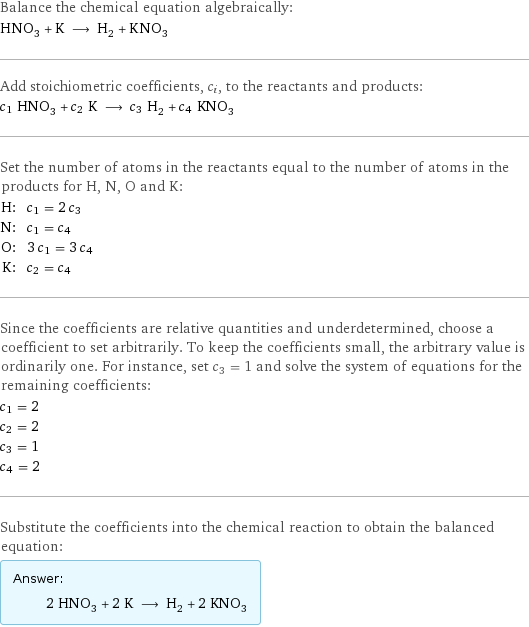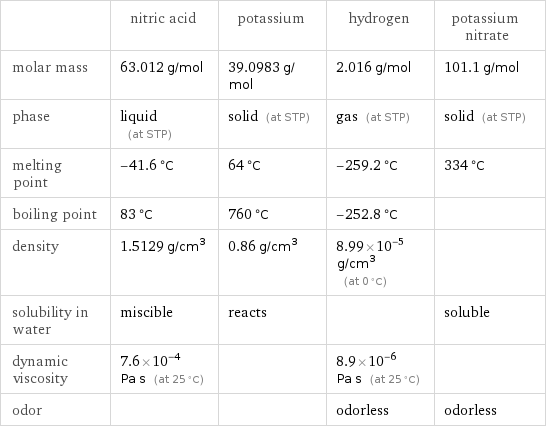Input interpretation

HNO_3 nitric acid + K potassium ⟶ H_2 hydrogen + KNO_3 potassium nitrate
Balanced equation

Balance the chemical equation algebraically: HNO_3 + K ⟶ H_2 + KNO_3 Add stoichiometric coefficients, c_i, to the reactants and products: c_1 HNO_3 + c_2 K ⟶ c_3 H_2 + c_4 KNO_3 Set the number of atoms in the reactants equal to the number of atoms in the products for H, N, O and K: H: | c_1 = 2 c_3 N: | c_1 = c_4 O: | 3 c_1 = 3 c_4 K: | c_2 = c_4 Since the coefficients are relative quantities and underdetermined, choose a coefficient to set arbitrarily. To keep the coefficients small, the arbitrary value is ordinarily one. For instance, set c_3 = 1 and solve the system of equations for the remaining coefficients: c_1 = 2 c_2 = 2 c_3 = 1 c_4 = 2 Substitute the coefficients into the chemical reaction to obtain the balanced equation: Answer: | | 2 HNO_3 + 2 K ⟶ H_2 + 2 KNO_3
Structures

+ ⟶ +
Names

nitric acid + potassium ⟶ hydrogen + potassium nitrate
Equilibrium constant
![K_c = ([H2] [KNO3]^2)/([HNO3]^2 [K]^2)](../image_source/17b631e7aba2d4a75df036a1ba8184a2.png)
K_c = ([H2] [KNO3]^2)/([HNO3]^2 [K]^2)
Rate of reaction
![rate = -1/2 (Δ[HNO3])/(Δt) = -1/2 (Δ[K])/(Δt) = (Δ[H2])/(Δt) = 1/2 (Δ[KNO3])/(Δt) (assuming constant volume and no accumulation of intermediates or side products)](../image_source/6a14a4ae19f37f7f5ad6d3ef234e272e.png)
rate = -1/2 (Δ[HNO3])/(Δt) = -1/2 (Δ[K])/(Δt) = (Δ[H2])/(Δt) = 1/2 (Δ[KNO3])/(Δt) (assuming constant volume and no accumulation of intermediates or side products)
Chemical names and formulas

| nitric acid | potassium | hydrogen | potassium nitrate formula | HNO_3 | K | H_2 | KNO_3 name | nitric acid | potassium | hydrogen | potassium nitrate IUPAC name | nitric acid | potassium | molecular hydrogen | potassium nitrate
Substance properties

| nitric acid | potassium | hydrogen | potassium nitrate molar mass | 63.012 g/mol | 39.0983 g/mol | 2.016 g/mol | 101.1 g/mol phase | liquid (at STP) | solid (at STP) | gas (at STP) | solid (at STP) melting point | -41.6 °C | 64 °C | -259.2 °C | 334 °C boiling point | 83 °C | 760 °C | -252.8 °C | density | 1.5129 g/cm^3 | 0.86 g/cm^3 | 8.99×10^-5 g/cm^3 (at 0 °C) | solubility in water | miscible | reacts | | soluble dynamic viscosity | 7.6×10^-4 Pa s (at 25 °C) | | 8.9×10^-6 Pa s (at 25 °C) | odor | | | odorless | odorless
Units
